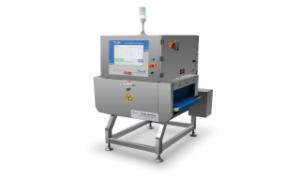Here’s how X-ray food inspection can help your factory
X-ray machines have been a
revolutionary technology ever since they have been used to save lives in the
medical field. The same X-ray technology can be used to help detect anomalies
in a production line. The food industry has almost internationally adopted
X-ray inspection due to its non-invasive nature, speed, and reliability. If you
are wondering how a piece of medical tech finds its place in the food industry,
let us dive deeper into the operating principle of a typical X-ray scanning
machine:
1.
The X-ray emitter: A source of radiation like a bulb produces the
radiation in an X-ray inspection machine. The bulb is enclosed inside a
protective cover to ensure the radiation does not leak out from the machine.
2.
The conveyer belt: The inspection machine uses a conveyer belt to
carry the food items through the radiation inside the machine. The conveyer
belt of the X-ray machine can be used as part of the broader production line,
ensuring an efficient flow of goods.
3.
The x-ray detectors: On the opposite side of the conveyer belt from the
bulb, is a detector that catches the radiations after they have passed through
the item to be scanned. Different packaging materials, food items, and
contaminants absorb radiation to different extents. The detector needs to be
sensitive enough to catch the variations in the radiation.
4.
Image processing: The data from the detector is then processed to
find details about the scanned item. This data helps the machine to detect any
foreign particles or defects in the product. The software can help convert the
data into images for human interfaces.
A win-win situation
The operating principle of the food
inspection machine is similar to the medical X-ray machine, but specifically tuned
to find abnormalities in food items. These machines can help you maintain
higher production quality while increasing the efficiency of the production
line. These scanning machines are automated, speeding up the process of
eliminating faulty products. Being a non-invasive method of scanning, it also
reduces wasteful product testing practices. The combination of all these
factors creates a win-win situation for the manufacturer.
Minimize wasteful practices
Traditional food testing occurs at
the final stages of production. Detecting any contamination at such a stage
leads to the loss of other raw materials, production time, and labor. Using
automated detection systems at the early stages of production gives more
accurate information about the contaminated raw material, saving both time and
money. X-ray inspection machines have also been found to provide more accurate
information about the finished product when compared to the traditional
practice of manually testing the products.
In conclusion
A robust food safety system is a must
for any food company for maintaining a coherent and consistent brand image.
Using state-of-the-art systems for scanning the products helps the company
adhere to stringent quality standards and eliminate any unwanted items reaching
the customer’s plate. You can choose from the best x-ray inspection machines online in Australia and easily get help from experts to help you choose
the ideal machine for your factory.
Social Bookmarking
https://linkit.vercel.app/group/82e04b
https://wussh.sznm.dev/optimaweightech
https://getallmylinks.com/optimaweightech
https://link.seg.br/optimaweightech
https://www.flowcode.com/page/optimaweightech
https://linktr.ee/optimaweightech
https://app.jotform.com/230523385395459
https://heylink.me/optimaweightech
https://www.instapaper.com/p/9786672
Article Submission
Press Release Submission
https://www.openpr.com/news/3858585/streamline-your-production-optima-weightech-s
Blog Submission
https://packagingmachinesaustralia.blogspot.com/2025/02/checkweigher-system-understanding-top.html
https://optimaweightech.livejournal.com/497.html
https://packagingmachinesaustralia.blogspot.com/2025/02/role-of-machines-for-packaging-in-food.html
https://optimaweightech.livejournal.com/538.html
Document Sharing
https://www.slideserve.com/optimaweightech/checkweigher-system-understanding-the-top-applications
https://www.slideserve.com/optimaweightech/role-of-machines-for-packaging-in-the-food-industry
https://www.4shared.com/web/preview/pdf/bHdfU9h-ge?
https://www.4shared.com/web/preview/pdf/e8jYvpZxjq?
https://www.4shared.com/web/preview/pdf/K-xx1I8pjq?
https://www.4shared.com/web/preview/pdf/8_Hbvf33fa?
https://pdfhost.io/v/PaHA2keP1_Checkweigher_System_Understanding_the_Top_Applications
https://pdfhost.io/v/BcKMEMI7u_Role_of_Machines_for_Packaging_in_the_Food_Industry
Business Profile Listing
https://clutch.co/profile/optima-weightech-pty
https://www.blinx.biz/optima-weightech-pty-ltd
https://speakerdeck.com/optima
https://www.openstreetmap.org/user/Optima%20Weightech%20Pty%20Ltd
https://www.addonbiz.com/listing/campbellfield-optima-weightech-pty-ltd/
https://startupxplore.com/en/startups/optima-weightech-pty-ltd
https://3dprintboard.com/member.php?149789-optimaweightech
https://www.b2bco.com/optimaweightechcomau
https://weboworld.com/listing/victoria/melbourne/Others/optima-weightech-pty-ltd
https://rewardbloggers.com/business-pages/optimaweightech
Video Submission
https://old.bitchute.com/video/J1EbtIaCDFKy/
https://www.unitymix.com/posts/49253
Infographic Submission
https://au.pinterest.com/pin/1126744400524900672
https://www.flickr.com/photos/196108662@N03/54322875598/
https://www.behance.net/gallery/219109219/Top-Suppliers-of-Reliable-Machines-for-Packaging
Quora Submission



Comments
Post a Comment